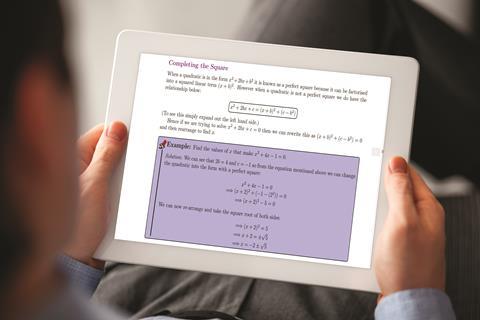Michael Grove and Samantha Pugh explore the ‘mathematics problem’ faced by chemistry students

For those working within the disciplines of mathematics, physics and engineering in higher education, the ‘mathematics problem’ is all too familiar. The term describes the well-documented issues associated with the lack of mathematical preparedness of students as they begin their university studies.1 While there has been considerable community-wide and institutional activity to tackle the problem, for example the development of mathematics support centres and a range of online learning materials, there is evidence that the problem may now be different in nature, so a different solution is sought.2
While the root causes of the mathematics problem in mathematics, physics and engineering have been identified, in chemistry, the situation has never been entirely clear. In 2007, the then chief executive of the Royal Society of Chemistry Richard Pike attributed the issue to students not studying mathematics beyond GCSE level. However, a year later, the Physical Sciences Subject Centre review of the student learning experience in chemistry, indicated that there was a mismatch between staff and student views of their preparation prior to starting a chemistry degree, even among the growing proportion who have studied A-level mathematics. Staff complained that students were ill-prepared in mathematics, but more than half the students surveyed said that the mathematics they did at school or college prepared them very well for their chemistry courses.
A serious attempt to understand the mathematics problem within chemistry has recently been undertaken by the Higher Education Academy.3 Their staff and student survey report attributed the problem to a number of issues including lack of confidence, a gap between studying mathematics and entering the degree programme, more mathematics than expected in the degree programme and a lack of explanation of the relevance of mathematics to chemistry. Perhaps most striking was that despite citing difficulties, the majority of students reported that they had not accessed the additional mathematics support that was available.
The research
In 2014, we established a programme of action research with the Universities of Birmingham and Leeds to investigate the specific nature of the mathematical issues affecting chemistry students and to identify what can be done from both a staff and student perspective to help alleviate these and identify areas where further research might be required.
Drawing on the expertise of a final-year mathematics and statistics graduate, we analysed historical data from two research-intensive chemistry departments. A third-year chemistry student researched the specific nature of the issues by conducting semi-structured interviews with academic staff. While there appears to be a tendency for chemistry departments to consider mathematics a ‘physical chemistry issue’, opinions were obtained from across organic and inorganic chemistry as well. Our findings indicated that the mathematics problem manifests across all areas of chemistry, particularly in relation to the skills required to support practical work.
Findings
Prior mathematical experience
Pre-university curriculum changes in 2000 reduced the number of students studying A-level mathematics to a record low, and with such a decline, the number of students with A-level mathematics choosing undergraduate chemistry was greatly diminished. Further, throughout this period, undergraduate science, technology, engineering and mathematics (STEM) numbers as a whole suffered a drastic decline and several high-profile university departmental closures were witnessed in chemistry. A crisis seems not to be too strong a word to describe the situation at the time.
In response, significant activity took place (between 2004 and 2012) to raise the profile of chemistry among young people. Interventions such as Chemistry: The Next Generation, and Chemistry for our Future led by the Royal Society of Chemistry and funded by the Higher Education Funding Council for England (HEFCE), were undertaken to address this decline. Data from HEFCE show this was achieved with some success. Between 2002/03 and 2011/12, A-level chemistry entries increased by 39% and mathematics entries by 55%. At undergraduate level, full-time equivalent chemistry enrolments increased from 11,414 in 2001/02 to 16,050 in 2011/12.

In 2011, some 61% of chemistry A-level students (n = 40,132) also studied A-level mathematics, and combinations of mathematics and chemistry accounted for the top four places (in total 16% of all combinations) in the most popular A-level combinations for Russell Group students (16%). This would seem to imply there are a greater number of students with both chemistry and mathematics going on to study chemistry at undergraduate level, but does data from the university sector support this?
The review undertaken by the Physical Sciences Subject Centre indicated that just over half the students responding (n = 328) had A-level mathematics, and in the recent Higher Education Academy Survey,3 in which 721 students provided details of their prior mathematical qualifications, 75% indicated they had studied mathematics to A-level standard or equivalent, although no distinction is made between those with full A-level and those with AS-level qualifications. Further, as of recruitment commencing in 2014, seven of the 24 Russell Group chemistry departments require mathematics as a compulsory subject, with 11 others asking for it as desirable.
Obtaining national data on chemistry undergraduates with A-level (or AS-level) qualifications is difficult, so two Russell Group chemistry departments (who did not require A-level mathematics) were considered as case studies. Results were mixed: one institution saw a steady increase in the number of students with A-level mathematics and the other remained broadly flat. Overall, 45% of chemistry graduates from one of the universities in the period 2009–2014 had some form of A-level mathematics qualification (pass or above), at the other the figure was 49% with a further 8% having AS-level, with at least two-thirds (within both) having A-level mathematics at grade B or above.
On the basis of this evidence, more chemistry students are studying more mathematics prior to university entry, and achieving the highest grades, yet the mathematics problem is reported as persisting. This would seem to dispel the idea that the mathematics problem in chemistry is down to many students having stopped formal lessons in mathematics two years earlier at the GCSE level and there are other factors that we need to understand.
Understanding the importance of mathematics in chemistry
Mathematics is an essential skill for chemistry students to master; the number of chemistry departments either requiring or recommending study of A-level mathematics is but one indicator. However, there exists a mismatch between staff and student understanding of its importance. For example, in the Higher Education Academy student survey,3 over a quarter of respondents claimed that the relevance of mathematics to chemistry had not been explained to them. In addition, about one third of respondents had found more mathematics than expected in the degree programme.
We mapped the mathematical skills and knowledge needed within a typical three-year chemistry degree (fig 1). A range of mathematical skills are required throughout a degree, but typically, the teaching of mathematics is predominately concentrated in Year 1.3

Interviews with staff indicated that one issue compounding the mathematics problem in chemistry is that the importance of mathematics is not typically reinforced throughout an undergraduate degree. Students will be introduced to mathematical concepts in Year 1, but then may not apply some of these (usually the most conceptually challenging) until later years. Students don’t have regular opportunities to apply their mathematical skills, and when they do, the emphasis is upon applications rather than understanding mathematical concepts. The situation is similar to those arriving with only GCSE mathematics; over time, students can lose fluency and understanding in the mathematical ideas and skills they developed in Year 1 as they are not continually, and explicitly, reinforced.
Is A-level mathematics the solution?
Within the two institutions we investigated, it was possible to compare how chemistry students with and without A-level mathematics performed during their first year. Students without A-level mathematics, or with lower than a grade B, must undertake a compulsory first-year module to introduce key mathematical concepts and techniques. A second compulsory module, focusing on the applications of mathematics in a chemistry context is taken by all students.
In one institution, the first module followed a common format, allowing questions to be categorised and analysed over five years. Perhaps most strikingly, students struggled consistently with re-arranging and simplifying equations, yet performed better when such tasks were combined with questions involving logarithms. However, there is a much more fundamental underlying trend that is exemplified by differentiation and topics such as integration, differential equations and definite integrals. Students performed consistently well when required to differentiate functions, but less so when integrating functions or solving differential equations (which require mastery of techniques in integration). To an extent, differentiation can be regarded as procedural with a series of rules that can be followed (product, quotient, etc.); integration, however, requires far greater conceptual understanding. The variability of scores on these topics suggests a number of students struggle with this mastery.
What we are advocating is that the mathematics in chemistry should not be hidden and results merely presented. Instead, it should be embraced and explained...
With the second module, we analysed performance based on question types from the entire cohort. The findings highlight that (broadly) all students were able to solve process-orientated questions such as converting units and calculating concentrations, but all students, regardless of whether they had A-level mathematics or not, struggled with more conceptual problems requiring the application of mathematics, for example: ‘Determine the minimum potential…’.
Academic staff commented that they felt that while students with A-level mathematics were generally more able and could perform well with formulaic or procedural mathematics questions, they struggled to take a conceptual chemistry problem, identify the necessary mathematical knowledge and techniques required, and then apply these to reach a satisfactory solution. Perhaps the issue that exists is not a lack of fundamental knowledge and ability, but an inability to apply mathematics to solve unfamiliar and conceptual problems. This is somewhat analogous with what is now being noted in mathematics and physics.2
Finally, we analysed the effect of an A-level qualification in mathematics on overall degree classification. The model developed suggests that in one institution, those without a mathematics A-level are predicted to do better than those with a grade C but worse than those with a grade B; in the other, there is no obvious consistent pattern between A-level mathematics and degree attainment over time, however, those with grades A and B are seen to do marginally better overall. Significantly, there is a greater variation amongst those without A-level mathematics, which requires further research.
Tackling the underlying problems
We have already seen that teaching mathematics to chemistry students is usually focused in the first year. Universities are increasingly offering additional support to aid student learning, although the extent to which students make use of these is not clear.3
Further issues were identified with the course structure not allowing students sufficient opportunities to develop their mathematical skills through application, and the reliance upon summative examinations as a means of assessing mathematical skills. Staff felt there was sufficient additional support, but that the students themselves needed to do more. This again is an interesting finding, particularly since a number of reports indicate the students themselves do not feel there is an issue with their mathematical skills and knowledge, again indicating a mismatch between staff and student views.
It was interesting to consider the teaching of mathematics to chemistry students more broadly across the sector. There can be a tendency towards the delivery approach of: ‘Don’t worry about the origin of the mathematics, put the numbers into this set of equations and you will get the result you need.’ This approach relies heavily on rote learning and does not develop an understanding of what happens if the situation changes or the problem is structured differently. The consequence is that students do not understand, or appreciate, the key underpinning mathematical ideas and how these apply in practice, leading to an inability to see how they might be applied to new problems. Letting students see how such results can be derived, even as an extension activity, allows them to be exposed to the basis of an idea they can draw upon in the future. What we are advocating is that the mathematics in chemistry should not be hidden and results merely presented. Instead, it should be embraced and explained, not necessarily for assessment (and this can be made clear to students), but to make it clear that mathematics is important within chemistry and a technique that needs to be mastered.
Developing support resources
During our research, it became apparent that in many cases, teaching the applications of mathematics to problems in chemistry takes place after basic mathematical ideas have been introduced, and usually as a separate module.

We identified a need to create a resource that would not only provide an overview of key mathematical ideas and concepts, but would also give examples of the kinds of chemistry problems that require mathematics. Working again with interns, we chose to develop an ebook (integrating print and digital content), designed to help first year chemistry students making the transition to university. We did not set out to replace existing text books. Our ebook provides students with an additional resource in a quick reference style, allowing them to explore key mathematical ideas quickly and succinctly. Its key feature is that it contains numerous examples demonstrating how the mathematics they learn is applied directly within a chemistry context. Most significantly, it has been developed as a partnership between chemists and mathematicians, and is based on findings from our research. The ebook is currently being used by first year students at the Universities of Birmingham and Leeds and is available for free download.
Emerging recommendations
Our work, in addition to the development of the ebook, has identified a number of recommendations or areas universities might like to consider when seeking to support chemistry students with learning mathematics:
- The importance of mathematics to chemistry should not be hidden. Staff surveyed indicated that A-level mathematics should not be compulsory for students to study chemistry; however, the importance of mathematics, and the desirability for A-level, should be advertised to potential future learners during school/college visits and in the recruitment prospectus.
- Opportunities for undergraduate students to apply mathematics to problems in chemistry should be offered alongside sessions that introduce the introductory mathematical ideas, perhaps through tutorials or peer-assisted learning sessions.
- There should be continual opportunities for students to apply and develop their mathematical skills throughout all aspects of their course (for example laboratories and lecture courses). In doing so, staff need to clarify why the mathematical techniques are important, and what the key mathematical ideas are to allow cross-referencing and independent study.
- Universities should consider when the teaching of mathematical ideas might best be introduced: is all upfront appropriate, or should they be distributed throughout the undergraduate degree programme?
- At key times, students should be directed to other forms of support that are available, for example, mathematics support centres, and their need to attend made clear.
- Finally, key mathematical ideas, concepts and results should not be hidden from students, but should be presented in ways that they can understand and appreciate.
Tackling the mathematics problem within any discipline will ultimately require changes to the curriculum, and there is much to learn from how other disciplines are beginning to address this issue. For us, a key feature in the success of our work, and the institutional enhancements that will result, has been the partnership between mathematicians and chemists; it is one we would recommend others explore.
We would like to acknowledge the student interns Beth Bradley and Rebecca Mills from the University of Leeds, and Allan Cunningham and Rory Whelan from the University of Birmingham. We also wish to acknowledge the work of Joe Kyle from the University of Birmingham in the development of the ebook.
Michael Grove is a senior lecturer and director of the STEM education centre at the University of Birmingham. Samantha Pugh is a lecturer in STEM education and teaching enhancement at the University of Leeds
References
- M D Savage and T Hawkes, Measuring the mathematics problem. Engineering Council, 2000
- M D Savage and M J Grove, Mathematical modelling and problem solving in real-world physical situations, Transitions in undergraduate mathematics education, M J Grove, A C Croft, J Kyle and D A Lawson. Higher Education Academy, 2014
- D E Shallcross and P C Yates, Skills in mathematics and statistics in chemistry and tackling transition. Higher Education Academy, 2014









No comments yet